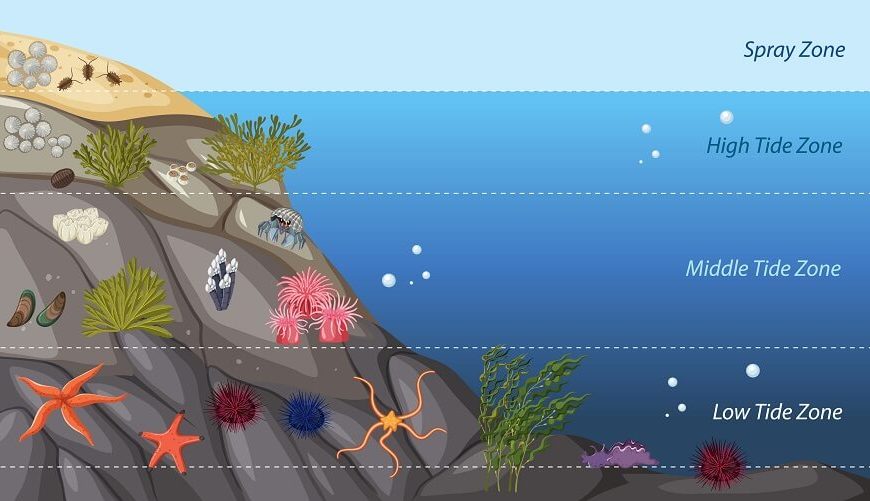As the sun began to set, little Niti sat by the seashore, her tiny fingers playing with the wet sand. She looked up at her mother with curious eyes and asked, “Maa, what lies beneath these waves?” Smiling, she replied, “A world more magical than you can imagine, my dear.” And thus began Niti’s journey into understanding the vastness and beauty of our oceans.
The ocean is a world that is filled with life, secrets, and wonders that have enthralled humanity for generations, not just a big body of water. For our little adventurers, learning about the ocean may be interesting and educational. So, let’s dive deep and explore the ocean zones for kids!
What are the four ocean zones? A Comprehensive Exploration
Our oceans’ vastness is divided into several levels, each of which has its own properties and forms of life. These layers, which are also known as zones, offer a methodical approach to comprehending the maritime ecosystem. Let’s delve deeper into these zones, for you may then be able to answer the question: What are the four ocean zones?
- The Sunlit Zone (Surface Zone of the ocean or top zone of the ocean):
- The Twilight Zone (Mid-Water Zone):
- The Midnight Zone (Deep-Water Zone):
- The Abyssal Zone:
- Why Should Children Learn About Ocean Zones?
Depth: 0 to 200 metres. Characteristics: Often referred to as the ocean’s “window,” the Sunlit Zone is where the sun’s rays penetrate, warming the waters and illuminating the surroundings. This zone experiences the most human activity, from swimming to boating. This is also known as the surface zone of the ocean or top zone of the ocean
Inhabitants: A bustling hub of marine life, this zone is home to a variety of species. Dolphins playfully glide through the waters, while sharks patrol their territories. Graceful jellyfish float by, and schools of fish dart around. The abundance of seaweed and plankton serves as a primary food source, supporting a thriving ecosystem.
Depth: 200 to 1,000 metres. Characteristics: As one descends deeper, the sunlight begins to wane, casting a twilight hue. The temperatures drop, and the environment becomes more serene and mysterious.
Inhabitants: This zone is home to some of the ocean’s most intriguing creatures. The elusive giant squid, with its tentacles stretching out, roams these depths. The anglerfish, with its natural lantern, lures its prey. Bioluminescent organisms light up this zone, creating a mesmerising underwater light show.
Depth: 1,000 to 4,000 metres. Characteristics: Venturing into the Midnight Zone is like entering an alien world. The sun’s rays are absent, making it a realm of perpetual darkness. The cold is biting, and the pressure can crush unadapted organisms.
Inhabitants: Despite the harsh conditions, life thrives. The deep-sea cucumber scavenges the ocean floor, while the basket star captures its prey with its intricate arms. The gulper eel, with its large mouth, is a sight to behold. These creatures have evolved unique adaptations to survive in this challenging environment.
Depth: 4,000 to 6,000 metres. Characteristics: The Abyssal Zone is the final frontier of the ocean depths. The intense pressure and cold make it a formidable environment. The ocean floor is a blanket of soft mud, with hydrothermal vents spewing minerals.
Inhabitants: Adaptation is key in this zone. Sea spiders crawl the ocean floor, while sea cucumbers filter nutrients from the mud. Worm species, like the tube worm, thrive near hydrothermal vents.
The ocean is a testament to the planet’s diversity and resilience. By introducing children to the ocean’s zones, we ignite their curiosity and foster a deeper appreciation for nature. They gain knowledge of the various coexisting life forms, the idea of adaptability, and the importance of biodiversity. Their perspective of the world is enriched by this information, which also highlights how crucial conservation is. It’s a captivating way to introduce foundational scientific concepts, making learning a delightful adventure.
Engaging Activities to Explore Ocean Zones with Kids:
- Layered Ocean in a Jar:
- Ocean Zone Flashcards:
- Visit an Aquarium:
- Ocean Zone Diorama:
- Interactive Ocean Zone Apps:
Bring the ocean to your home! Using water, food colouring, and various objects like sand and pebbles, create a layered representation of the ocean in a clear jar. As children layer the colours, they gain a tactile understanding of the ocean’s zones. This activity not only educates but also hones their motor skills and understanding of density and stratification. Plus, the finished jar serves as a beautiful decorative piece, reminding them of their oceanic adventure.
Visual learning is impactful. Design flashcards with vivid images of sea creatures. Challenge your child to match each creature to its respective zone. It’s an interactive way to reinforce their knowledge. These cards can be used for memory games or storytelling sessions, making the learning process multifaceted. Over time, children will not only recognise the creatures but also recall intriguing facts about their habitats.
An aquarium visit is a journey into the marine world. Children can witness the marvels of the ocean, from the vibrant coral reefs to the enigmatic deep-sea creatures. It’s a blend of entertainment and education. The tactile exhibits often found in aquariums allow children to touch and feel certain marine species, bridging the gap between theory and reality. Moreover, interactive sessions with marine biologists can further pique their interest and answer their budding questions.
Encourage your child to craft a diorama using shoeboxes. They can paint, draw, and use craft materials to represent each zone and its inhabitants. This hands-on activity fosters creativity and understanding. By visualising and constructing each layer, children develop a spatial understanding of the ocean’s depth and complexity. Displaying their diorama at home can also boost their confidence and serve as a conversation starter with guests.
In this digital age, numerous apps offer virtual tours of the ocean. Children can navigate the zones, interact with creatures, and even partake in quizzes. It’s learning at their fingertips! These apps often come with augmented and virtual reality features, providing an immersive experience. The gamified challenges and rewards system in many of these apps can motivate children to delve deeper and explore more, making learning both fun and rewarding.
We hope that you had great fun exploring the ocean zone for kids! The ocean, with its vastness and mysteries, is a mirror to our universe’s grandeur. Each zone, with its distinct characteristics and inhabitants, narrates a tale of nature’s marvel. By introducing our young ones to these ocean activities tales, we sow the seeds of curiosity, respect, and responsibility. As they embark on this journey of discovery, they not only learn about the world beneath the waves but also about their role in preserving it. At the heart of every ripple in the ocean lies a story, and it’s our privilege and duty to pass these ocean activities stories on to the next generation.
And speaking of fostering love and learning, EuroKids is dedicated to providing a nurturing environment for your child’s early education. With a curriculum that blends care and learning, EuroKids is the perfect place for your child’s holistic development. After all, every journey of discovery begins with a single step, and at EuroKids, we ensure that step is taken with confidence and joy.
Let the waves of knowledge engulf the curious minds of our children, for in their questions lies the future of our world.
















